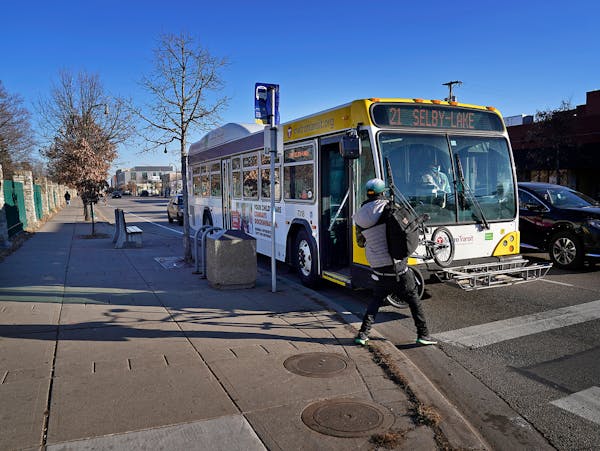Although delighted with his new house in Uptown, Alan Wiggs still misses the convenient access to light rail he enjoyed while living in downtown Minneapolis.
But come 2024, that will change when the B Line begins service.
The $65 million arterial bus rapid transit line will connect Uptown with Union Depot, operating primarily along Lake Street in Minneapolis and Marshall and Selby avenues in St. Paul.
"I am very excited about the B Line," said Wiggs, a bank employee who doesn't have a car. Now, visiting friends or going to shows in the capital city using public transportation is "time consuming."
The B Line will largely replace Route 21, the slowest bus route in Metro Transit's system, and the second busiest. It will also connect to the Blue and Green light-rail lines, as well as five other current or planned bus rapid transit (BRT) lines throughout the Twin Cities.
"When we talk about a fully connected system, this line is the epitome of that," said Deb Barber, chair of the Metropolitan Council's Transportation Committee.
On Wednesday, the Met Council, the regional planning body building the B Line, is expected to approve all 33 stations, most of them just shy of a half-mile apart.
That's one reason why arterial BRT service is about 20% quicker than stalwart (and pokey) local buses that stop more frequently.
The B Line buses will run every 10 minutes during the day and part of the evening, seven days a week. Passengers pay before boarding at the front or midsection of the bus, eliminating lines. Stations are heated and well lit. And the buses have signal priority at intersections.
But unlike light rail, arterial buses operate in traffic, so they are prone to the wiles of congestion as well as potholes and winter-worn city streets.
The B Line is a key initiative supporting Lake Street, a critical commercial corridor in Minneapolis that was damaged in the unrest following the murder of George Floyd last year.
Matt Kazinka, senior strategic initiatives manager of the Lake Street Council, said the investment is welcome.
"Faster and more reliable bus service will benefit many residents, visitors and employees who rely on transit to travel along the Lake Street corridor to get to their homes, workplaces and favorite businesses," he said.
Since the 2016 opening of the A Line, which connects the Blue Line's 46th Street light-rail station in Minneapolis to Rosedale mall, mostly along Snelling Avenue in St. Paul, Metro Transit has rolled out an ambitious plan to expand the arterial BRT system.
The C Line along Penn Avenue in north Minneapolis followed three years later, and the D Line on Chicago and Fremont avenues is expected to begin service next year.
Metro Transit's network of rapid buses is seen as a national model in transit circles, attracting passengers at a time when bus ridership is down.
And in Minnesota, where Republican lawmakers are hesitant to fund light-rail projects, arterial BRT is seen as an economical alternative.
But there are some downsides. While slow, Route 21 service is convenient because of its many stops, a positive for the elderly, people with disabilities and local businesses. Once B Line begins service, Route 21 service will be cut to every 30 minutes.
Kazinka said the Lake Street Council wishes "transit services could sustain both the arterial B Line bus and the current local service of the 21 bus in full, but [is] glad there will be major improvements at B Line stations, including better lighting, heating and security features."
Still, planning a transit line can be complicated, as COVID-19 ravaged ridership on public transportation. Metro Transit says the decline on the A and C arterial BRT lines was less extensive during the outbreak than on other types of service, such as commuter buses ferrying suburbanites to the cities.
"It's going to be a great benefit for existing riders, but we hope other people will be interested in giving transit a try," said Adam Smith, Metro Transit's senior planner for BRT projects.
Fast, frequent and reliable service, along with an improved experience taking the bus "makes a difference," he said.
It's still unclear whether parts of Lake Street will feature bus-only lanes for the B Line.
Smith says "a number of bus-priority treatments, perhaps bus-only lanes," along Lake Street will be considered. Metro Transit will work with Hennepin County and Minneapolis officials to determine whether they will be incorporated into the project later on.
Carolyn Parnell, 'trailblazer' who served as Minnesota's first IT commissioner, dies


